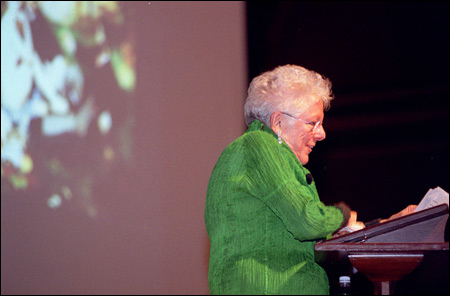Linda Nochlin looks at bathers
Seeing Renoir from multiple perspectives

Pierre Auguste Renoir’s 1887 painting “The Great Bathers,” a depiction of voluptuous female nudes cavorting in an idealized woodland pool, has elicited much critical response from art historians, particularly during the past few decades as feminist theory entered the discourse of art criticism.
This past Tuesday (Feb. 24), a near-capacity audience in Sanders Theatre heard a lecture on “The Great Bathers” by an art historian regarded by many as the founder of feminist art criticism.
Linda Nochlin, the Lila Acheson Wallace Professor of Modern Art at New York University’s Institute of Fine Arts, is this year’s holder of the Norton
Harvard Norton Lecture Series 2004 continues Tuesdays at 4 p.m.,
Sanders Theatre.
- March 2: ‘Manet’s “Le bain” and the death of the historic landscape’
- March 9: ‘The Man in the Bathtub: Picasso’s “Le meutre” and the gender of bathing’
- March 23: ‘Monet’s “Hôtel de la Roche Noire”: Anxiety and perspective at the seashore’
- April 27: ‘Real Beauty: The body in realism’
- May 11: ‘”More Beautiful than a Beautiful Thing’”: The body, old age, ruin, and death.’
Professorship, a prestigious chair established in 1925 and occupied by some of the 20th century’s most celebrated scholars, writers, and artists. Tuesday’s lecture was the first of a six-part series.
Nochlin’s talk began with a quotation from “Appetites: Why Women Want” (2003) by the late Caroline Knapp, whom Nochlin described as “a passionate student of anorexia.” The passage celebrated Renoir’s painting as an image of abundance, strength, softness, and female sensuality in which “the appetites exist in full circle.”
Lest anyone imagine that Nochlin herself was the author of this panegyric, she immediately distanced herself from Knapp’s words and declared that when she first read them, she “wanted to hurl the book across the room.”
Nochlin, who has sought to demystify the male artist as self-created genius by viewing creativity as a function of social conditions and whose work has brought attention to the presence of the “male gaze,” initially found Knapp’s rhapsodic reaction to the painting “pernicious.” But she admitted that in looking at Renoir’s work she also experienced “an undertow of attraction.”
She could imagine that female viewers, especially of Renoir’s own time, might find the painting liberating as a fantasy of freely expanding flesh, of the pleasure of “lolling about, exposed to air and light,” unconstrained by corsets or whalebone stays.
Early in her talk, Nochlin warned her audience that they should not expect a neatly theoretical interpretation of the painting but rather a “piecemeal deconstruction” or “interpretive collage” in which she would make no attempt to reconcile disparate views. And so it was in that spirit that she introduced yet another interpretation of the painting suggested by a psychotherapist friend.

This view emphasized the presence in the painting of an androgynous female figure in the foreground looking at and playfully splashing the two fuller, rounder figures who sprawl on a rock to the left. According to this psychodynamic interpretation, the interaction of the women suggests a homoerotic dimension, a blurring of the boundaries between the sexes that allows both male and female viewers to enter the sensual fantasy world of the painting.
Building on this insight, Nochlin reminded her audience that the painting comes from that period, the 1880s and 1890s, when artists and writers were experimenting with the notion of ambiguous sexuality, “the Oscar Wildeing and George Sanding of Europe.”
It was also a time when bathing and swimming were enjoying a new popularity among both women and men as a form of health-giving exercise. Nochlin showed a succession of slides illustrating this growing trend, engravings from the popular press showing women in modestly baggy bathing costumes splashing about in the new “piscines” or swimming pools, as well as satirical drawings by the artist Honoré Daumier mocking these grotesque and misshapen “Naiads of the Seine.”
Parisian attitudes were divided on the subject of water sports for women. On the one hand, immersion in the “pure” water of the upper Seine (the early piscines were enclosed barges that let in the river water) was considered healthy and edifying. On the other hand, it was feared that the piscines were becoming the haunt of theater women and others of low moral character who would pollute the premises by drinking and smoking and generally carrying on like men.
But in addition to reflecting contemporary preoccupations with women and water, Renoir’s painting, in Nochlin’s view, also represents a change in artistic style, driven in turn by social and economic forces.
In contrast to Renoir’s earlier impressionistic works, which portray a realistic, albeit consistently sunny, world in which men and women interact in recognizable settings, “The Great Bathers” presents an idealized world divorced from the modern urban milieu. In technique, it eschews the loose brushstrokes and dappled play of light of the impressionist period for a firmer, more sculptural rendering.
While Renoir’s earlier work shows men and women interacting socially, the work of the 1880s puts “the male artist outside the world viewed. History and social order are precluded in order to produce an ideal reality, representing a return to solid values.”
It was also a time when market forces were demanding artists with unique styles and specialized subject matter. Renoir with his monumental bathers was responding to that market pressure, Nochlin said.
Summing up her “interpretive collage” with a consistently inconclusive ending, Nochlin asserted that while serious attention needs to be paid to the historical context out of which “The Great Bathers” emerges, the painting, like all art, “needs to be shaken out of its historical context because only in that way can it become new again.”




